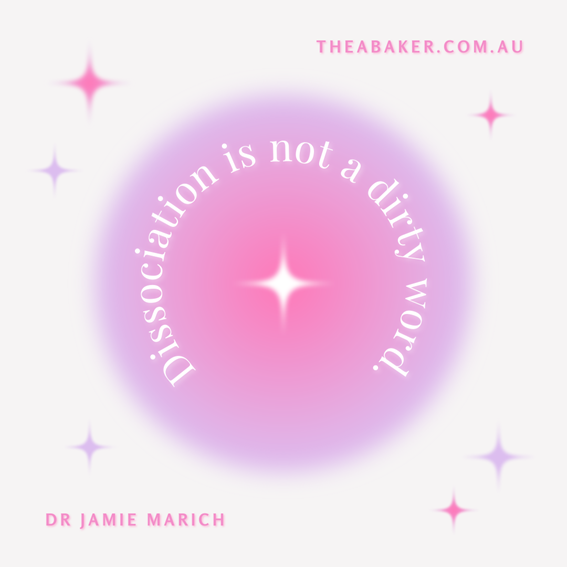Dissociation is not a dirty word
Dissociation is not a dirty word
First off, I was intending on following last week’s blog with a discussion around Complex Post-Traumatic Stress Disorder (or C-PTSD / Complex Trauma) but I’ve been away this weekend at the EMDRAA (EMDR Association of Australia) conference in the Gold Coast and I feel really strongly motivated to speak about one of the very common ‘symptoms’ or experiences that people who have C-PTSD report – dissociation. Secondly, I didn’t come up with the snappy title for this week’s blog either! It’s something that I heard from the mouth of the incredibly humble and authentic Dr Jamie Marich – and they also had some super fun merch with this phrase on, so I’ve even got a sticker that reads the same! And, as Jamie was sharing her experiences both as a human with lived experience of Dissociative Identity Disorder (DID) and as a clinician and researcher in the fields of trauma and addiction, I realised that ‘dissociation’ is something I’d never specifically written about on here – yet it’s something I talk about often in session!

The reason it comes up a lot in session is because dissociation is a common human experience – ALL of us would probably be able to identify with the experience of ‘daydreaming’ or even not remembering how we arrived at work some mornings but somehow, we find ourselves in the car park! We’re present in the world but also somewhat disconnected from the world around us. Those are both examples of (non-clinical) dissociation. However, dissociation can be seen as something of a continuum with the daydreaming example being at one end of the spectrum, and with diagnoses of DID at the other end:

And as you can see from this image, when someone has experienced trauma we often find that they are more likely to experience more significant dissociative episodes to the point where a sense of being disconnected from both self and the world is more common.
Within the DSM-5 (think diagnostic ‘bible’ for mental health) dissociation is defined as: “a disruption, interruption, and/or discontinuity of the normal, subjective integration of behaviour, memory, identity, consciousness, emotion, perception, body representation, and motor control.” But the word ‘dissociate’ comes from a Latin root that means to sever or separate. And so, when we view it through a psychological – and more specifically a trauma lens – we might see it as a separation from perhaps our thoughts, memories, physical bodies, other people and / or our lives. And from this trauma perspective we might see it as a truly helpful thing – because when our nervous system is flooded by experiences that are so horrid, thank goodness our brain has a way of separating us from it all.
To understand though what this looks like from a mental health / diagnosis perspective we have the following clinical appreciations:
Dissociative amnesia occurs when we lose the ability to recall information about ourself — not simply ‘forgetting’ — following a traumatic or stressful event in our life and can include:
- Localised: this is the most common type where we might be unable to remember an event or a period of time such as an evening or day
- Selective: when we aren’t able to remember certain parts of an event or events during a specific period of time.
- Generalised: more uncommon and involves us completely losing our identity and the history of our life.
Depersonalisation and derealization disorders involve the significant ongoing or recurring experience of:
- Experiences of unreality or being detached from our mind/thoughts, self, and/or body (i.e., depersonalisation)
- Experiences of unreality or being detached from our environment and/or other surroundings, which makes things and/or people in the world feel not real (i.e., derealisation)
- A combination of both depersonalisation AND derealisation
Dissociative Identity Disorder (which used to be known as multiple personality disorder) is frequently associated with significant ongoing trauma that started in childhood. The experience of DID involves two or more distinct identities – that are accompanied by changes in behaviour, memory and thinking, the presence of memory gaps related to everyday events, personal information, and/or trauma. DID is much more common than we might think – there’s some data that suggests there are as many people who are left-handed as there are humans with DID. Given the prevalence of Adverse Childhood Experiences (‘ACE’s’ –> see last week’s blog for more information) this might not be surprising – but there’s still a problematic stigma associated with DID that truly doesn’t serve humans that have already experienced more than their nervous systems can tolerate.
Within more trauma-informed and inclusive spaces where there’s an appreciation that DID doesn’t always have to be ‘resolved’ (i.e., all identities integrated), and that for some humans, a full and meaningful life might look like an adaptive living-with or alongside the different identities. The important thing is to understand what each person with DID seeks to achieve in terms of their mental health / life functioning. Language is also important – some people use terms like ‘alters’, others use ‘parts’ and some people have names / ages / or terms like ‘littles’ that make sense of their complex inner worlds. Of course it would be remiss of me not to flag that appropriate (trauma-focused) therapy, with a person that is trained in trauma psychotherapies and who is ‘safe enough’ to work with can make a huge difference!
If this blog has prompted you to better understand trauma and your own experiences of dissociation, would like a safe space to talk about how they may impact your mental health, please get in touch with us: www.theabaker.com.au / hello@theabaker.com.au / 03 9077 8194.
